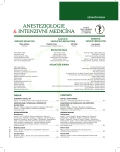Epidemiology of out-of-hospital cardiac arrest in the Czech Republic – national results of the EuReCa ONE trial
Authors:
R. Škulec 1,2,3; R. Šín 4,5; J. Knor 2,6; R. Sviták 7,8,9; O. Franěk 10; P. Mokrejš 11,12; E. Smržová 1,13; J. Dudáková 2; A. Truhlář 3,14
Authors‘ workplace:
Klinika anesteziologie, perioperační a intenzivní medicíny, Masarykova nemocnice v Ústí nad Labem
Univerzita J. E. Purkyně v Ústí nad Labem
1; Zdravotnická záchranná služba Středočeského kraje, Kladno
2; Klinika anesteziologie, resuscitace a intenzivní medicíny, Fakultní nemocnice Hradec Králové, Lékařská
fakulta v Hradci Králové, Univerzita Karlova
3; Zdravotnická záchranná služba Plzeňského kraje, Plzeň
4; Fakulta biomedicínského inženýrství ČVUT v Praze, Kladno
5; 3. lékařská fakulta, Univerzita Karlova
6; Anesteziologicko-resuscitační oddělení, Nemocnice Hořovice
7; Jednotka intenzivní péče, Neurochirurgická klinika, Fakultní nemocnice Plzeň, Lékařská fakulta v Plzni
Univerzita Karlova
8; Zdravotnická záchranná služba Plzeňského kraje, Plzeň
9; Zdravotnická záchranná služba hlavního města Prahy, Praha
10; Anesteziologicko-resuscitační klinika 1. lékařské fakulty Univerzity Karlovy v Praze a Thomayerovy
nemocnice Praha
11; Zdravotnická záchranná služba Libereckého kraje, Liberec
12; Zdravotnická záchranná služba Ústeckého kraje, Ústí nad Labem
13; Zdravotnická záchranná služba Královéhradeckého kraje, Hradec Králové
14
Published in:
Anest. intenziv. Med., 28, 2017, č. 3, s. 176-182
Category:
Overview
Objective:
At present, there is still a knowledge gap regarding the epidemiology of out-of-hospital cardiac arrest (OHCA) in Europe and in the Czech Republic. Therefore, the EuReCa ONE (European Registry of Cardiac Arrest) international epidemiological study was performed to determine the incidence of OHCA, the cardiopulmonary resuscitation process and OHCA outcome throughout Europe. Here we present national data from the Czech Republic.
Design:
Prospective, observational, multicentre, epidemiological study.
Setting:
Emergency medical services.
Materials and methods:
Emergency medical services of the Central Bohemia, Hradec Kralove, Pilsen, Karlovy Vary, Liberec and Usti nad Labem regions and the City of Prague participated in the study. All the patients who suffered an OHCA during the month of October 2014 attended by the Emergency Medical Service were eligible for inclusion in the study. The data were collected and analysed according to the latest version of the Utstein style.
Results:
Data covering a population of 4,532,758 inhabitants were analysed. Incidence of confirmed OHCA events with any kind of cardiopulmonary resuscitation attempt was 98.19 cases/100,000 inhabitants/year. Initial shockable rhythm was recorded in 22.5 % patients. Incidence of return of spontaneous circulation was 30.18 cases/100,000 inhabitants/year. Total 16.69 % patients survived for at least 30 days or to hospital discharge, equivalent to 16.36 cases/100,000/ inhabitants/year. Clinically relevant interregional variability was observed in all parameters.
Conclusion:
The results of EuReCa ONE confirm that OHCA is a major public health problem with considerable incidence and clinically relevant interregional differences.
KEYWORDS:
out-of-hospital cardiac arrest – cardiopulmonary resuscitation – incidence
Sources
1. Herlitz J, Bahr J, Fischer M, Kuisma M, Lexow K, Thorgeirsson G. Resuscitation in Europe: A tale of five European regions. Resuscitation 1999;41 : 121–131.
2. Atwood C, Eisenberg MS, Herlitz J, Rea TD. Incidence of EMS-treated out-of-hospital cardiac arrest in Europe. Resuscitation 2005;67 : 75–80.
3. Gräsner JT, Herlitz J, Koster RW, Rosell-Ortiz F, Stamatakis L, Bossaert L. Quality management in resuscitation – towards a European cardiac arrest registry (EuReCa). Resuscitation 2011;82 : 989–994.
4. Gräsner JT, Meybohm P, Fischer M, et al. A national resuscitation registry of out-of-hospital cardiac arrest in Germany-a pilot study. Resuscitation 2009;80 : 199–203.
5. Soar J, Nolan JP, Böttiger BW, et al. European Resuscitation Council Guidelines for Resuscitation 2015 Section 3. Adult advanced life support. Resuscitation 2015;95 : 100–147.
6. Gräsner JT, Lefering R, Koster RW, et al. EuReCa ONE – 27 Nations, ONE Europe, ONE Registry. Resuscitation 2016;105 : 188–195.
7. Gräsner JT, Böttiger BW, Bossaert L. EuReCa ONE – ONE month – ONE Europe – ONE goal. Resuscitation 2014;85 : 1307–1308.
8. Perkins GD, Jacobs IG, Nadkarni VM, et al. Cardiac Arrest and Cardiopulmonary Resuscitation Outcome Reports: Update of the Utstein Resuscitation Registry Templates for Out-of-Hospital Cardiac Arrest. Resuscitation 2015;96 : 328–340.
9. Mikešková M, Folwarczny P, Gřegoř R, Zoubková R, Nytra I. Analýza mimonemocničních netraumatických náhlých zástav oběhu na území Moravskoslezského kraje. Urgentní medicína 2013;16 : 20–22.
10. Franěk O. Přednemocniční resuscitace v Praze v roce 2013. Urgentní medicína 2014,17 : 20–23.
11. Franěk O. Telefonicky asistovaná první pomoc (TAPP) – doporučený postup výboru UM a MK – ČLS JEP. Urgentní medicína 2007;10 : 22–26.
12. Franek O, Pokorna M, Sukupova P. Pre-hospital cardiac arrest in Prague, Czech Republic – the Utstein-style report. Resuscitation 2010;81 : 831–835.
Labels
Anaesthesiology, Resuscitation and Inten Intensive Care MedicineArticle was published in
Anaesthesiology and Intensive Care Medicine

2017 Issue 3
Most read in this issue
- Epidemiology of out-of-hospital cardiac arrest in the Czech Republic – national results of the EuReCa ONE trial
- Pulmonary trauma by energy load – ventilator-induced lung injury
- Healthcare associated pneumonia in intensive care patients – optimal choice of initial empirical antimicrobial therapy: Results of a multicenter, observational study
- Practical application of the results of clinical trials
